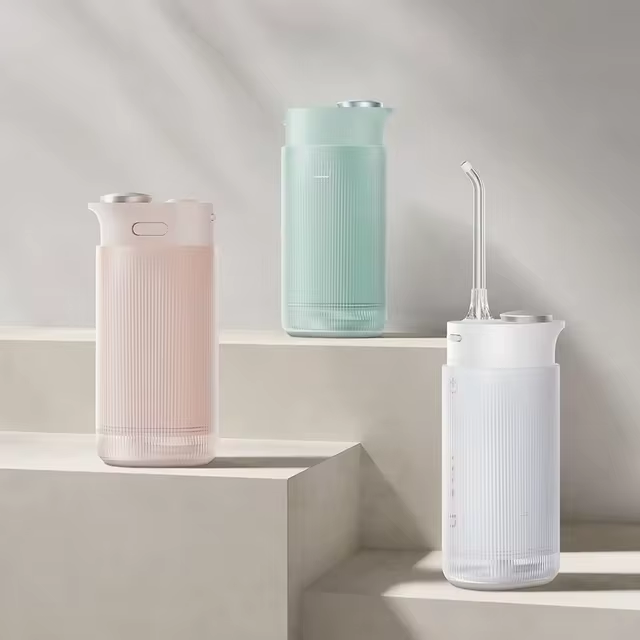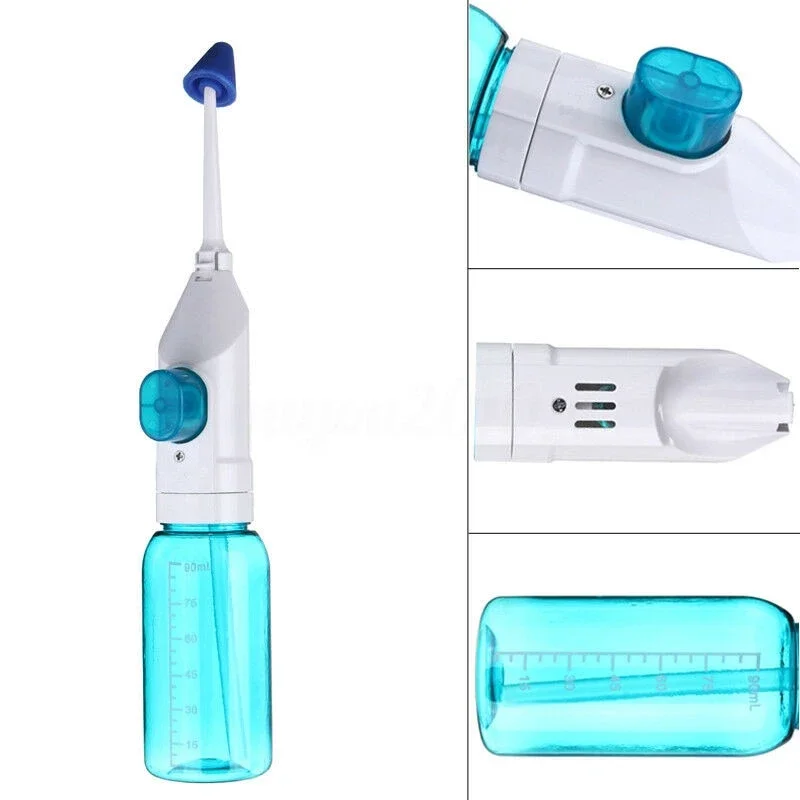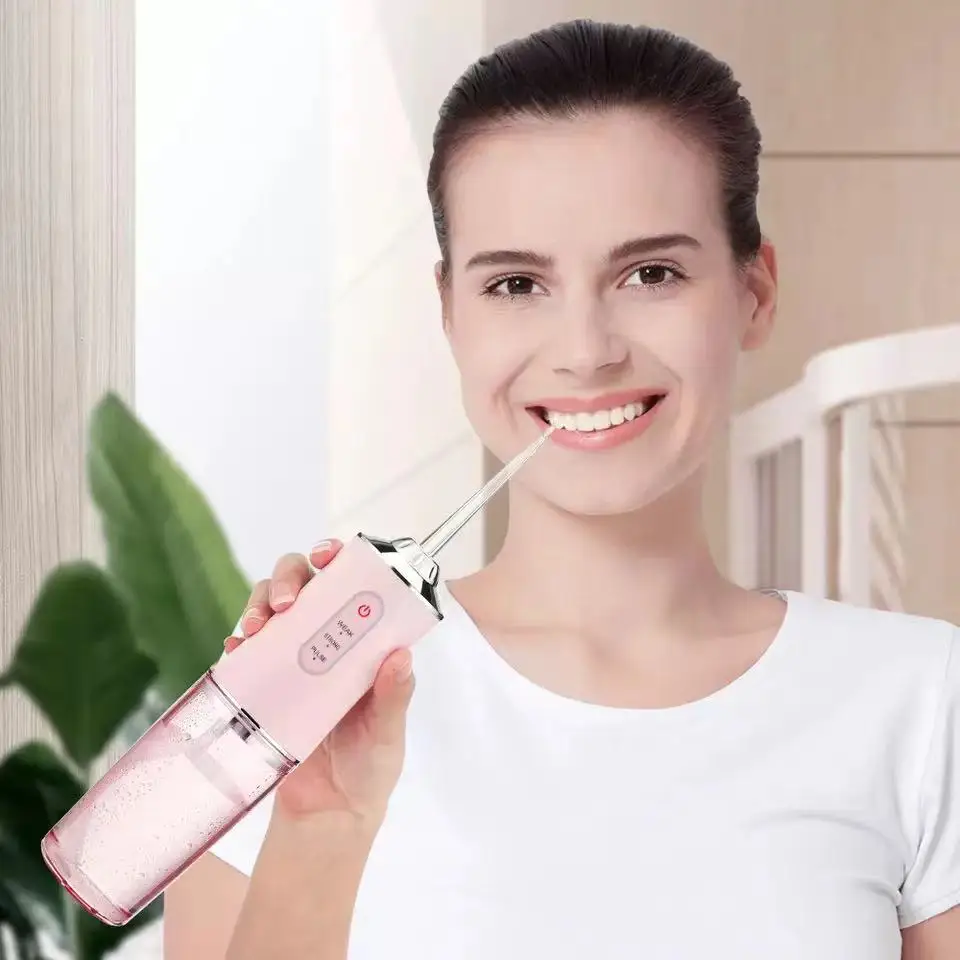Introduction to water flosser
How does a water flosser work? Water flossers, often known as oral irrigators, are devices that clean between teeth using a stream of water. These devices provide a simple and effective way to enhance dental hygiene, especially for those with braces or other dental appliances. Water flossers are gaining popularity due to their ease of use and effectiveness in removing food particles and plaque from hard-to-reach areas.

Types of Water Flossers
There are several types of water flossers available in the market, each designed to meet specific needs. The most common types are:
- Countertop Water Flossers: These models have a stationary base and are typically more powerful with adjustable settings. They are ideal for home use.
- Cordless Water Flossers: These are portable, battery-operated, and perfect for traveling or small bathrooms. They offer convenience but usually have fewer features and lower water pressure compared to countertop models.
- Faucet Water Flossers: These attach directly to a faucet, providing endless water supply without the need for refilling. They are easy to install and use.
- Shower Water Flossers: These connect to a shower pipe, allowing you to floss during your shower. This integration simplifies the routine and saves time.
Each type of water flosser offers specific benefits. Users should choose based on their lifestyle, needs, and the level of convenience they are looking for.
Benefits of Using Water Flossers
Using a water flosser can greatly improve your oral health routine. It offers several benefits over traditional string floss. Water flossers are easier to use, particularly for those with dental appliances and can be more effective at removing plaque in hard-to-reach areas.
Comparison with Traditional Dental Floss
When comparing water flossers to traditional dental floss, several points stand out. First, water flossers can reach areas that string floss may miss, reducing plaque and the chance of gum disease. They also eliminate the need for awkward hand movements, making flossing less of a chore.
Traditional floss can be very effective when used properly, but it also has downsides. It can be tough to maneuver, particularly for those with arthritis or other hand mobility issues. Plus, it might not clean as thoroughly around braces or underneath bridgework.
Advantages for Braces and Dental Work
For those with braces or extensive dental work, water flossers offer clear advantages. They easily clean around brackets and wires where string floss would struggle. The ability to adjust the water pressure allows for a gentle yet effective cleaning that can be customized for comfort, which is critical for sensitive gums and teeth.
Using a water flosser can prevent food particles from lodging in areas that a toothbrush or dental floss cannot easily reach. This helps to maintain better dental hygiene and prevents issues that might require additional dental work. They are particularly helpful for people with braces as they can flush out food debris from around brackets and wires with ease.
How Water Flossers Work
Understanding precisely how a water flosser works can help you utilize it effectively.
Mechanism and Technology Behind Water Flossers
A water flosser cleans by ejecting a strong stream of water. The water comes from a reservoir inside the device. The motor pumps the water through a specially designed tip at differing pressures.
This water jet reaches between teeth and under the gumline. As it pulsates, it dislodges food debris and plaque. This process is akin to power washing surfaces, but for your teeth. It’s effective for areas too tight for floss or where gums may be sensitive.
Most devices allow you to adjust the pressure. This means you can use a gentle stream or a more robust jet, depending on your sensitivity and cleaning needs. Moreover, the tips can be changed to better target specific areas, like braces or periodontal pockets.
The use of a water flosser is a combination of pressure and pulsation. The pressure dislodges food particles; the pulsation helps gum health. Improved gum health is due to the massaging effect that promotes good circulation.
For optimal oral health, water flossers should complement regular brushing. They don’t replace toothbrushes or traditional floss but work alongside them to enhance dental hygiene.
 Proper Usage of Water Flossers
Proper Usage of Water Flossers
To maintain oral health, knowing how to use a water flosser is vital. Here’s a simple guide.
Step-by-Step Guide on Using a Water Flosser
- Fill the reservoir with warm water for comfort.
- Choose the correct tip for your needs.
- Start with the lowest pressure setting.
- Lean over the sink to catch water.
- Place the tip at a 90-degree angle to your gums.
- Guide the tip along the gumline and between teeth.
- Pause briefly between teeth for thorough cleaning.
- Clean all areas, including around dental work.
- Empty the reservoir and clean the unit after use.
Remember to use your water flosser daily for best results and complement it with brushing and traditional flossing.
Tips for Optimal Results
- Use warm water to minimize sensitivity.
- Begin with lower pressure settings and adjust as needed.
- Focus on each tooth and gumline section for a few seconds.
- Recharge or replace batteries regularly for cordless models.
- Incorporate water flossing into your evening routine for an effective clean.
By following these steps and tips, you can boost your dental hygiene and enjoy the full benefits of your water flosser.
Maintenance and Care for Water Flossers
Proper maintenance extends the life of your water flosser and ensures it functions effectively.
Cleaning and Upkeep
Regular cleaning is crucial for your water flosser. Start by emptying the water reservoir after each use. This prevents mold build-up. Use a soft, damp cloth to wipe the exterior. For the tip and internal parts, run warm water through the device without electronics, mimicking the flossing process. This dislodges any residue.
To deep clean, mix a solution of water and white vinegar. Use a soft brush on the tip and reservoir. Let the solution cycle through before rinsing thoroughly with clean water. Preventive care includes inspecting the cord and body for signs of wear and replacing old tips every six months. Implement these maintenance tips to keep your water flosser in optimal condition.
Potential Drawbacks
While water flossers offer a number of advantages, there are some limitations and considerations to keep in mind.
Limitations and Considerations
Water flossers require access to electricity and water, which may not always be convenient. They can be bulkier than traditional floss, making them less ideal for travel. The initial investment is also higher than purchasing dental floss. Additionally, some people may find the water stream messy until they get used to the device.
Water flossers do not completely replace the need for string floss. They might not remove plaque as thoroughly, especially on the surfaces between tightly packed teeth. Users must still practice good brushing and use string floss to ensure the best oral hygiene.
Maintenance is key. Water flossers contain reservoirs and tips that need regular cleaning to prevent mold and bacteria build-up. This can be more involved compared to the simplicity of string floss.
Furthermore, water flossers can be noisy, which may be a disturbance to others. Adjusting to the right water pressure is important to avoid gum discomfort or damage. It’s best to start on a low setting and increase as you adapt to the sensation.
Despite these drawbacks, many find the benefits of using water flossers outweigh the limitations. Proper use and care can minimize some of these issues, leading to an effective and enjoyable flossing routine.
 Choosing the Right Water Flosser
Choosing the Right Water Flosser
Choosing the right water flosser can significantly enhance your dental care routine. Given the variety of models available, it’s crucial to consider several factors to ensure you select one that suits your needs perfectly.
Factors to Consider When Buying a Water Flosser
When selecting a water flosser, keep these key considerations in mind:
- Type of Water Flosser: Decide between countertop, cordless, faucet, or shower models based on your convenience and space availability.
- Pressure Settings: Look for a flosser with adjustable pressure settings to control the intensity of the water stream, catering to sensitivity and specific dental needs.
- Tips and Attachments: Ensure it comes with different tips or attachments for various uses such as orthodontic cleaning or accessing periodontal pockets.
- Size and Portability: If you travel often, a compact and cordless model might be more suitable.
- Ease of Use and Maintenance: Consider how simple it is to use and clean. Models with straightforward mechanisms tend to offer better longevity and hygiene.
- Price: Balance your budget with the features you need. Don’t compromise crucial functionalities for cost, but avoid overpaying for unnecessary features.
Recommended Models and Brands
Several brands stand out for their effectiveness and user satisfaction:
- Waterpik: Often recommended by dental professionals, known for comprehensive models that cater to various needs.
- Philips Sonicare: Offers models that are effective and come with various attachments.
- Panasonic: Known for producing reliable and easy-to-use water flossers.
- Oral-B: Provides effective water flossers with a range of pressure settings and tips.
When choosing a water flosser, comparing these models and considering the factors listed above will help you find the best fit for your dental care regime. Opt for a model that effectively combines functionality, ease of use, and value for money to enhance your oral hygiene.